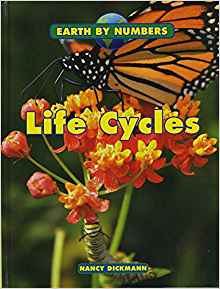-
Life Cycles: Pack B
Clare Hibbert
Paperback (Raintree Publishers, May 10, 2005)Designed specially for young independent readers, aged between 6 and 8, the "Perspective" collection combines core non-fiction features - including an emphasis on research skill - with a visual design that encourages readers to look at these topics in a different way. "Life Cycles" books follow the life of an animal or plant as it changes. In some cycles there is a dramatic change, such as that from caterpillar to butterfly. In others the changes is gradual but no less fascinating, as when the book covers such familiar animals as dogs and cats.
-
Life Cycles
Nancy Dickmann (author)
Hardcover (Raintree, Aug. 9, 2018)None
-
Life Cycles
Katie Marsico, John Willis
Hardcover (Weigl, July 1, 2016)Do-It-Yourself Experiments introduces readers to the scientific process. Clear, step-by-step instructions let readers explore the world of science through well-crafted, hands-on experiments. Colorful photos, informative illustrations, and easy-to-read text make the topics appealing and accessible to young readers. O
O
-
Life Cycles
Sian Smith
Hardcover (Capstone Global Library Ltd, Aug. 1, 2011)These highly-illustrated books provide an overview of core curriculum areas for Key Stage 1. They can be used in the library by children, or in the classroom by teachers to introduce a curriculum topic.
-
Life Cycles
Sue Barraclough, Charlotte Guillain
Paperback (Heinemann Library, Sept. 26, 2008)None J
J
-
Life Cycles
Sue Barraclough, Charlotte Guillain
Hardcover (Heinemann Library, Sept. 26, 2008)What hatches out of frogspawn? Do reptiles lay eggs? What kind of baby animal drinks milk? 'Investigate' encourages science enquiry with an interactive, investigative, and visual approach to a wide range of core curriculum topics. The format allows students to use scientific processes such as prediction, hypothesis, and inference in answering a series of questions on important topics throughout the book. O
O
-
Life Cycles
Julie K Lundgren
Paperback (Rourke Publishing (FL), Aug. 1, 2010)The Life Cycles series is a fresh approach to a timeless topic. Beautiful photographs and creative design make each life cycle come to life for all readers. Each book includes a model of the life cycle as well as information on the habitat that the plant or animal lives in. M
M
-
Life Cycles
Clare Hibbert
Library Binding (Raintree, Sept. 30, 2008)None
-
Life Cycles
Wendy Conklin
eBook (Teacher Created Materials, May 20, 2015)Plants, insects, snakes, salmon, eagles, elephants, humans; these living things all pass through a life cycle from birth to adulthood. Examine moth cocoons, the feather gills of a salamander larva, beaver yearlings, and more to discover how each life cycle is different and unique! Colorful images and fun facts paired with age-appropriate text will keep third-grade students engaged from the beginning to the end of this e-book! Featuring a hands-on "Think Like a Scientist" lab activity that is aligned to the Next Generation Science Standards, this e-book helps students apply what they've learned in the text and supports STEM instruction. Helpful diagrams and text features, such as a glossary and index, are also included to improve content-area literacy. P
P
-
Life Cycles
Angela Royston
Hardcover (Raintree, April 7, 2016)Life Cycles introduces how animals' lives can be very different, from 70-year-old elephants to adult mayflies that only live a few hours. It also looks at similarities too, such as how comparing a cuckoo and a cheetah illustrates how many animal parts are similar. Readers will gain a basic understanding of animal life cycles as they read about examples from all over the world.
-
Insect Life Cycles
Molly Aloian, Bobbie Kalman
Hardcover (Crabtree Pub Co, Oct. 31, 2005)Discusses the anatomy, development, and reproduction of segmented invertebrates, including rhinoceros beetles, swallowtail butterflies, and stinkbugs. M
M
-
Life Cycles Pack a
Darlene R Stille
Paperback (Raintree, July 14, 2016)None